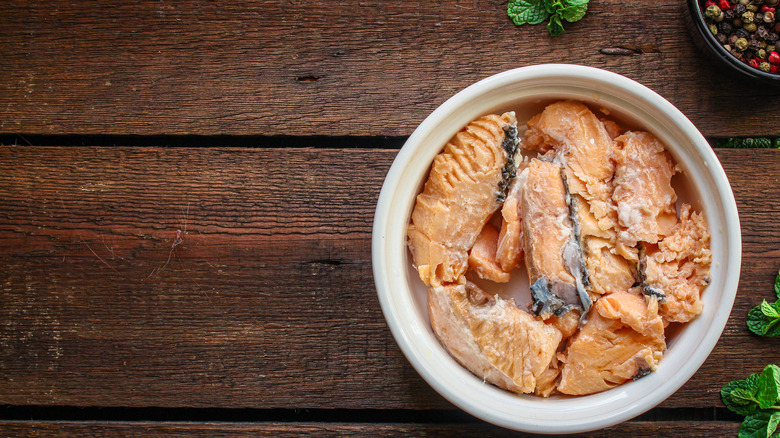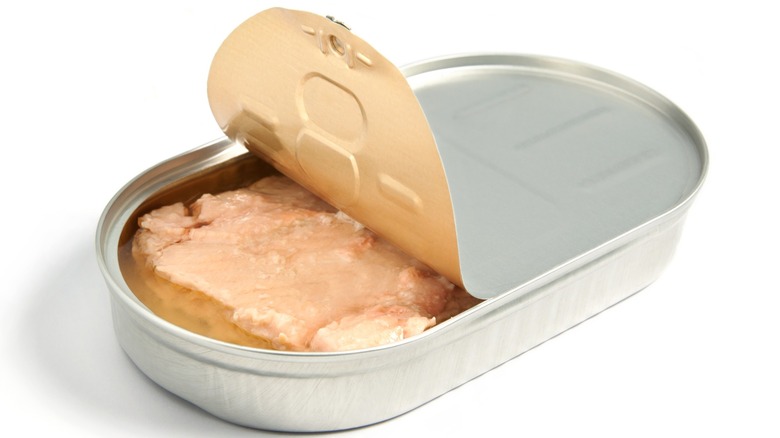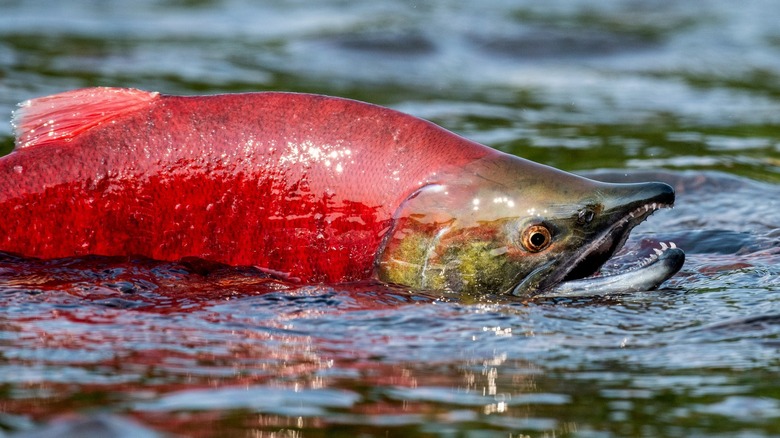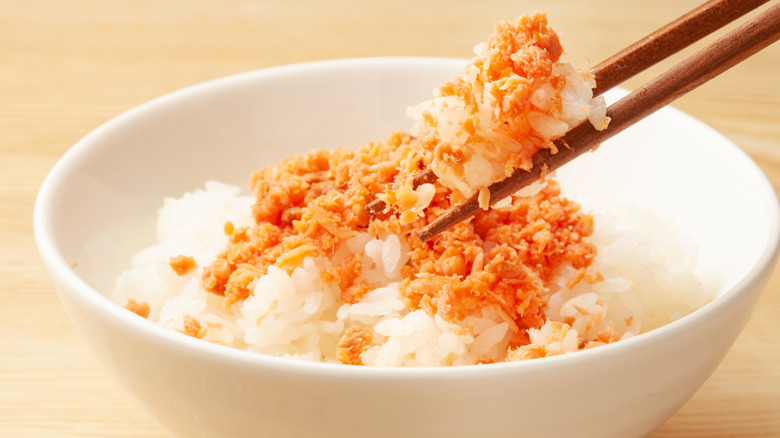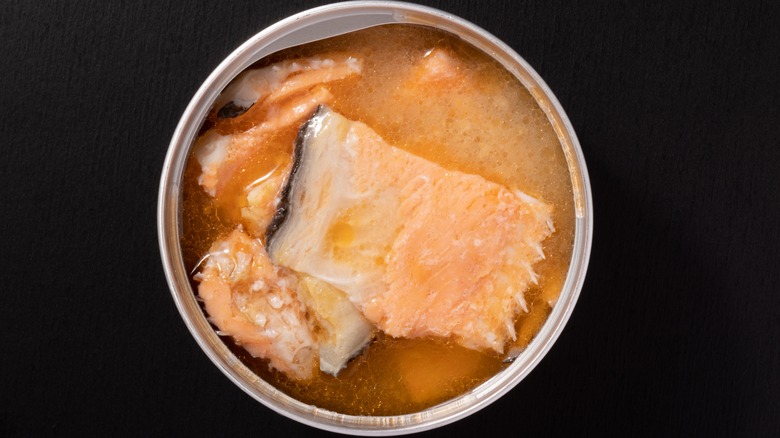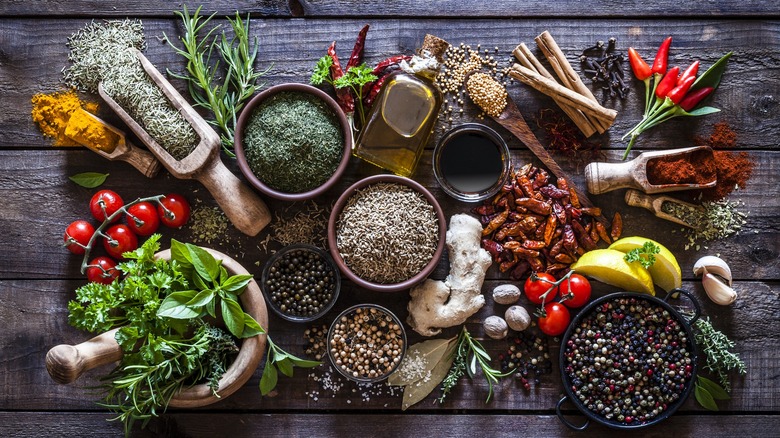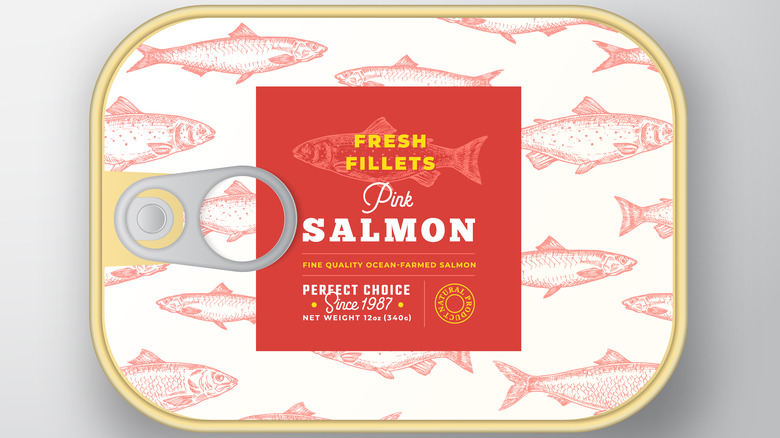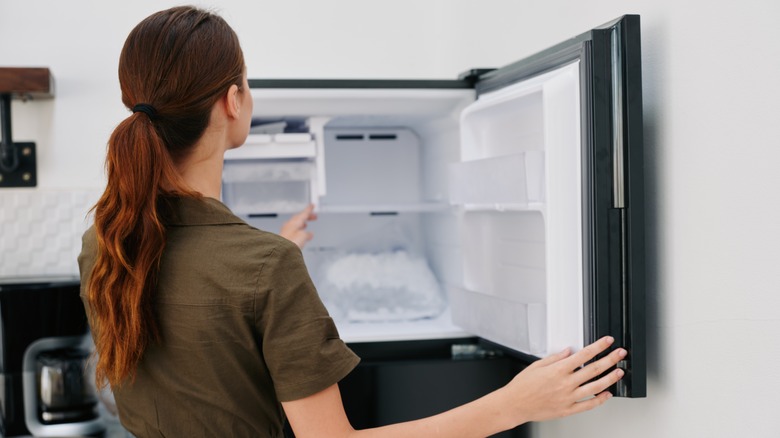8 Mistakes You're Probably Making With Canned Salmon
The essence of life is eating a balanced diet. Not only does doing so provide you with pepperings of flavor here and there, but it also gives you the vitamins and minerals you need to be healthy. One way to have that balanced diet is to consume fish, especially fish rich in omega-3 fatty acids, like salmon. However, groceries can be expensive. On top of that, your wallet may not fare too well if you start buying fresh fish regularly.
While usually not as versatile as fresh fish — except when making a salmon loaf – canned salmon is a fantastic alternative to fresh salmon. You'll enjoy the same great taste, as well as the essential vitamins and minerals, and your bank account won't suffer. Yes, canned salmon can be a no-brainer to use, but it's still possible to make errors when eating and cooking it. Here are eight mistakes you're probably making with canned salmon and what you can do to rectify them.
1. Not draining it properly
When you open up a can of salmon, the first thing you probably notice is the liquid the fish is sitting in. You should absolutely drain canned salmon before eating, as this liquid can dilute flavors and affect the texture of your dish (making it overly soft and squishy), no matter what you're putting the salmon in. You can even rinse the meat to dilute the fish smell if you don't like it. This smell may be stronger in lower-quality brands of canned salmon. What's great is that draining and rinsing have little impact on the nutritional value, so you're still getting those vital nutrients.
The easiest way to drain and rinse salmon starts by dumping out the can's contents into a strainer. This will eliminate all liquids and leave behind the meat. You can then rinse it directly under the tap if you wish. However, if you don't have a strainer, there are still ways to get rid of the liquid. The simplest way is to completely open the top, push it back down onto the surface of the salmon (so that it holds the meat in but allows the liquid to escape) then tip the can upside-down. For another method, instead of opening the top, you can first puncture two holes in the can and then drain the liquid through those holes.
2. Using the wrong type of salmon
You might be surprised to learn this, but there isn't only one type of salmon out there. There are five main species of Pacific salmon found in North America, as well as one found in the Atlantic Ocean, and two found in Asia. Most people in North America might be familiar with species like pink, sockeye, and coho.
Each type of salmon has a unique flavor and texture, even when canned. Consider your recipe carefully to determine if the fish should be the shining star or a warm complement to the dish. For example, if you want the salmon to punch your taste buds in the face, opt for sockeye, as it has a richer flavor profile. On the other hand, if you want a milder taste, go with coho — it's also lighter in color, so if you want a more baby-pink aesthetic, this type of salmon is optimal. For a real treat, get chinook (king) salmon, as it's high in fat and has a texture that'll melt in your mouth. In addition, watch out for the canned salmon brands you're buying, as that'll affect flavors too. Typically, the cheaper, lower-quality brands will have a more fishy smell and a harder texture — you get what you pay for.
3. Overcooking the salmon
During the canning process, the salmon is cooked thoroughly, so you won't have any raw pieces to deal with. While this may sound like it makes things easier, you'd be shocked. All too often, people cook canned salmon as if it were raw, then they end up with tough pieces that aren't pleasant and ruin the meal. The good news is that the canned stuff can be cheap enough that it doesn't hurt too much financially if you mess up your tinned salmon preparation. However, it's disappointing when an otherwise excellent dish takes on an unrecognizable texture.
We're not saying you have to eat it straight from the can to keep the meat tender. There are many ways to upgrade canned salmon, but if you're heating it, it's best to add it later in the cooking process. That way, the meat will still be hot, but it won't be overcooked to the point that your tinned fish becomes lifeless hunks reminiscent of pet food.
4. Not removing the bones and skin
When you buy fresh salmon, it often comes with the salmon's skin and bones attached. Many people assume that canned salmon doesn't have either since it's been through a whole preservation process. This is where they're wrong. To make your tinned salmon dishes more pleasant, you should remove both the skin and bones. This will leave you with tender, smooth meat that's easy to eat. You can easily do this by using tweezers to pick through the meat.
Technically, you don't need to take the bones out. The canning process makes the bones super soft, so your throat won't get pricked with each bite. You can even eat the skin. You'll find nutrients like iron, calcium, and omega-3s in this exterior. The skin is soft and fatty too, which some people find pleasant. But others will find a more pleasant texture when skin and bones are removed. If you don't like the texture that comes from the bones and skin but still want to reap their nutritional benefits, you can blend the canned salmon and use it for things like patties.
5. Skipping seasoning
Because canned salmon is ready to eat, you can spoon it from the can to your mouth — or the dish you're making. However, if you look at the ingredients list, you'll most often find just three things: water, salt, and oil. Does that sound exciting to you? Probably not, and we don't think so either.
It'll do in a pinch to add canned salmon directly to whatever you're eating, this isn't the pinnacle of outstanding cuisine. You should add herbs, spices, and other seasonings to enhance your meal. For example, freshly ground black pepper will instantly elevate your food. Some other spices, herbs, and seasonings to consider include garlic powder, onion powder, dill, and Italian seasoning. It all depends on what you're making. For example, parsley elevates the salmon loaf, dill complements salmon cakes, and scallions blend well with a salmon souffle.
Do be conscious of how much salt you're adding though, as a few brands either add salt or can salmon in saltwater. You can always drain and rinse the meat to reduce the sodium content significantly.
6. Not storing leftovers correctly
There may come a time when you won't use the entire can of salmon. For the sake of convenience, you might pop the can into the fridge so you don't have to dirty more utensils or containers. If you're up to it, you might even put plastic wrap on the top with a rubber band to keep air out. That way, the fish will stay good for longer, and it won't stink up the refrigerator, right? If you've never done this before, then you'll quickly find out the hard way that the fishy odor will penetrate the plastic wrap and fill up your fridge.
According to the U.S. Department of Agriculture, you can keep unused salmon in the can and put it straight into the refrigerator. However, this will compromise both its quality and flavor. For better results, you should place the leftovers in an airtight container, whether it's plastic or glass (glass is chemically inert, meaning it won't mess with the taste of the food you're storing, according to a 2012 article published by Environmental Health Perspectives). You should use the leftover canned salmon within four days.
7. Keeping the can after the expiration date
After you've been grocery shopping, it's easy to stock your pantries and forget about stuff that's been in there forever. Your canned salmon may have started at the front of the shelf, but as time went on, it got pushed further and further back into the recesses of your pantry to be forgotten. Years later, you're doing a deep clean, and you pull out these cans. You see that the expiration date was years before, but you're not one to waste food, so you don't want to throw away your cans.
You don't necessarily have to immediately trash your expired cans of salmon. According to the University of Alberta, you can still eat canned fish 1-2 years past the best-before date. Of course, you should use your eyes and nose to determine whether to keep or chuck things out. This goes for every can, whether it's two days or a year past the best-before date. To tell if the salmon has gone bad, see if the can is damaged or leaking, if the salmon smells bad, or if you see mold in the can. If so, then say goodbye to those cans, to avoid food poisoning.
8. Freezing the salmon in its can
Have you picked up a ton of canned salmon because there was an irresistible sale? You're trying to plow through your supply, but there's only so much fish you can take before you get sick of it. You don't want the salmon to go to waste, especially if the best-by date is soon. It may last a while afterward, but it's better to be safe than sorry. You've got some extra freezer space, so you're considering storing the tinned fish in there.
The good news is that the USDA says that food poisoning bacteria don't grow in the freezer, which means if your canned salmon is unspoiled, it'll stay that way in there. Plus, Oregon State University says that frozen canned goods can be eaten if the seams are still intact and the lids aren't bulging. But it's best to put your canned salmon in freezer-safe containers. You'll avoid damage that can happen due to temperature fluctuations or collisions with other items, which can potentially lead to leaks or contamination. These containers can be made of rigid plastic or glass. With the latter, make sure the containers are intended for freezing and canning. These can withstand extreme temperatures, meaning they won't burst.
To freeze canned salmon efficiently, first, drain it of all liquids. If possible, choose a wide-mouthed container so it's easy to put the salmon in and take it out. Finally, put the lid on tightly to prevent freezer burn from happening.
